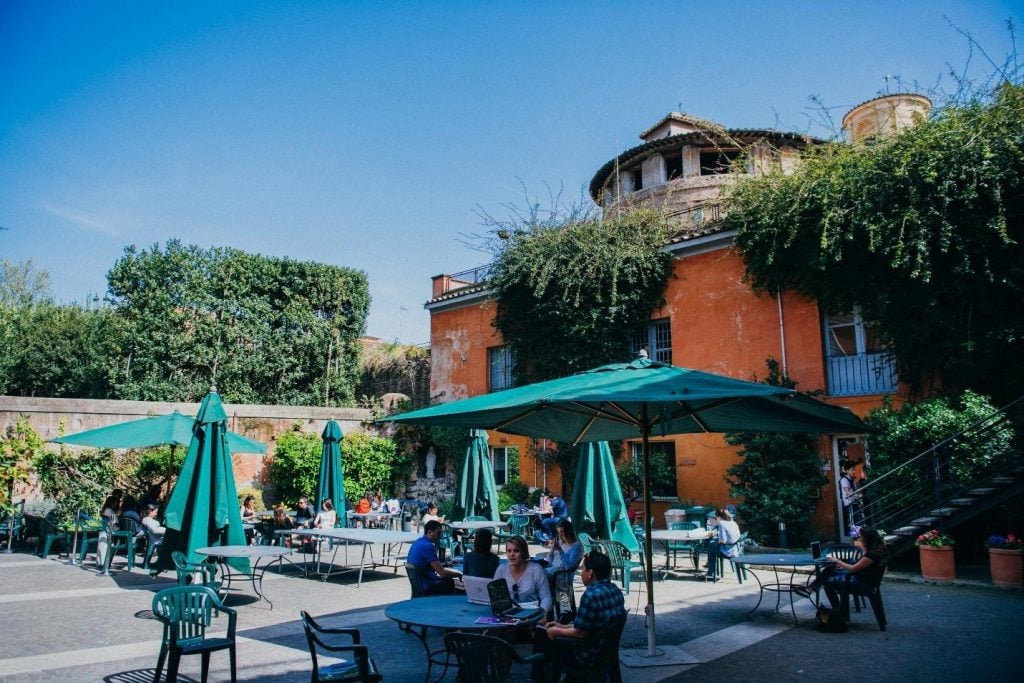

Giovanni Caboto, otherwise known as John Cabot, was a 15th century navigator and explorer from Italy. His work connected Italy to North America, and opened doors to further exploration, making him the perfect namesake for an American school in Italy that brings students together from all over the world.
JCU was founded in 1972. It has three campuses, all within close range of one another in the historical Trastevere neighborhood, which is brimming with culture and activity. Read on for some interesting facts about our Tiber, Guarini, and Caroline Critelli Guarini campuses—you may be surprised by just how rich their history is!
The John Cabot Tiber Campus Rests Between two Historic Bridges
The Tiber Campus features both student and immigration services—and it’s also where you can grab a bite to eat. The Tiber Cafe is our cafeteria, where you can find breakfast, lunch, and dinner, Monday through Friday. This campus rests in Lungotevere Raffaello Sanzio, which is on the banks of the Tiber River and sits between Ponte Sisto and Ponte Garibaldi, two of Rome’s bridges. They both serve to connect parts of the city, representative of the connections John Cabot University forms that surmount geographical barriers.
Ponte Garibaldi was built between 1884 and 1888, designed by architect Angelo Vescovali. The bridge was added to in 1959 and served the purpose of connecting Trastevere to the rest of Rome. Giuseppe Garibaldi is its namesake, and was known as the “hero of two worlds” for his work with Italian unification.
Ponte Sisto was originally built over a previous bridge’s ruins, Pons Aurelio, which in 792 was destroyed by flooding and abandoned. In 1475, architect Baccio Pontelli was commissioned to rebuild the bridge by Pope Sixtus IV. This was for the Jubilee Year, in preparation for pilgrims travelling to Vatican City.
Guarini Campus was once a Convent
Guarini Campus is where you can find the beautiful Aula Magna Regina auditorium. It also hosts one of the most expansive English libraries in Italy, the Frohring library. A meditation garden also provides quiet moments of rest on this campus. If you visit the upper reading room here, you may be interested to know that it was once the location of a chapel. In fact, Guarini Campus used to be a convent.
This campus is named after Frank Joseph Guarini, an American of Italian descent who was born in 1924 and has spent much of his life involved with education. He is a World War II veteran with a background in law and politics. A former chairman of the John Cabot board of trustees, Guarini is a large supporter of the school.
The Largest Donation in JCU History Helped Create the Caroline Critelli Guarini Campus
The Caroline Critelli Guarini Campus houses administrative offices as well as classrooms. The campus is a single building and an annex, made possible by the largest donation in JCU history, from Frank J. Guarini. The building is named after his mother, who lived to be 101 years old, and whose memory will continue to inspire others through the Caroline Critelli Guarini Campus.
The campus is located in Piazza Giuseppe Gioachino Belli, which features a statue commemorating the poet Giuseppe Gioachino Belli, whose sonnets are an important part of Roman literature. His works are written in Roman dialect and are now an integral piece of the history of Rome.
Are you interested in how you can study in Italy?
Contact John Cabot University for more information!




